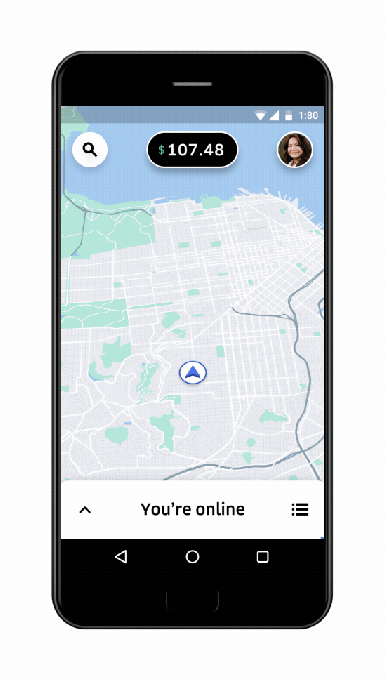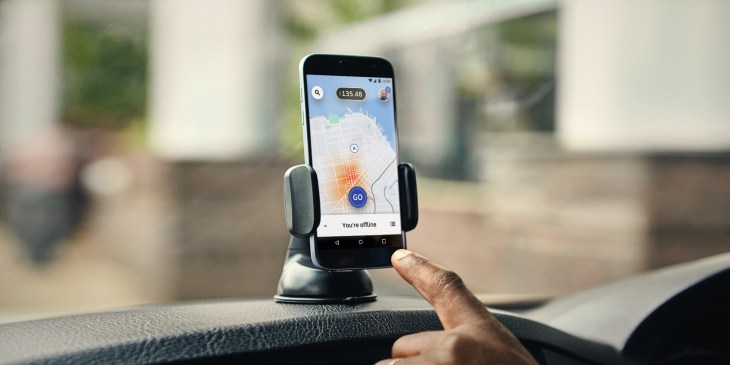Uber is rolling out a new app for drivers starting today. The hope with the redesign is to make it easier for drivers to access the information they need the most, while ensuring the app is not a distraction while behind the wheel, three Uber driver app product leads told TechCrunch last week. Earnings and incentives, for example, are important to drivers.
“One of the things we wanted to do with the new app is just recognize that this is the most important thing for you and put it front and center,” Uber Driver Experience Group Manager Yuhki Yamashita told me at Uber’s headquarters last week.
With the new app, Uber makes it easy for drivers to recognize where surge, boost and incentivized areas are located.
“Say you’re in a slow area,” Yamashita said. “We might actually suggest a place to go to instead because it’s much busier. And in this way you get a little bit more information about what’s happening around you. We get to answer questions like ‘well what should you be doing next.’ And you know it feels like the app understands your current situation.”

Other notable additions are the distance left to travel (before, it was just time to arrival) and one-tap responses to riders. So, if a driver is stuck in traffic, they can quickly tap “stuck in traffic” to notify the rider. Another one is an offline mode feature, which solves the problem of what happens when a driver doesn’t have good internet connectivity.
“What they had to do was drive until they had internet and then start the trip and then end the trip,” Yamashita said. “And that sometimes means that in certain markets you’re driving until the next town to actually end the trip and it makes it look like the trip was really long.”
Now, Uber will record the drivers GPS and once the driver regains connectivity, Uber will be able to make any appropriate adjustments. This is all part of Uber’s 180 days of change, which aims to make amends for the wrongs the company has done in the past.
“While 180 Days was about correcting missteps of the past, we also needed to think longer term, and the obvious place to start was the Driver app,” Uber CEO Dara Khosrowshahi wrote in a blog post. “It sits at the center of the driver experience, but after a redesign two years ago, it was already showing its age. We knew we couldn’t take the approach we’d taken in the past: redesign the app based on what we thought drivers wanted, launch it, then hope for the best. Instead we needed to listen to what drivers told us they needed, and shape the new app alongside them.”
Uber has been testing the driver app with 470 drivers across seven cities worldwide, incorporating their feedback along the way.
“So what we did during the beta was we actually sent teams of builders, teams of people who worked on the app, into every one of these seven cities to spend a real significant amount of time with drivers, with better drivers, in those cities talking to them,” Uber UX Researcher Bjorn Hubert-Wallander told TechCrunch.
![]()
During that process, Uber realized that while drivers liked being able to quickly see their earnings, “they felt a little uncomfortable with the idea of it being so visible on the screen, Hubert-Wallander said. They expressed concern about passerbys or riders knowing their business.
“It’s not necessarily even that other people are literally seeing their earnings,” Hubert-Wallander said about some drivers in Egypt. “It’s the idea that like that they’re making their earnings and the good fortune visible. This really invites bad luck so it doesn’t feel right to do that.”
In response to that feedback, Uber added a privacy setting so that drives can hide their earnings if they want.
Uber is initially launching the new driver app in Los Angeles and Atlanta, and nine or 10 cities in other countries. The hope with the gradual rollout is that Uber will be able to see if the app produces any ripple effects in the marketplace.
For example, with the new app directing drivers to places where there are incentives, there could potentially be a shortage of drivers in other less-populated areas, resulting in longer wait times for passengers. As part of Uber’s marketplace test, it will fully launch the driver app in a select number of cities and observe what happens when everyone has it.
“We’ll see if it produces unideal behaviors like that and compare it against sister cities,” Yamashita said. “We’re taking it slow to understand all the sorts of side effects.”
